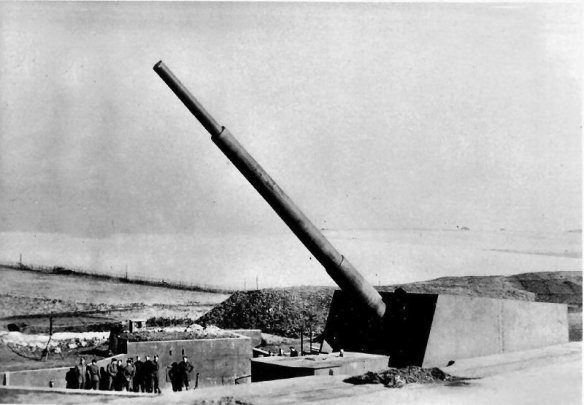British long-range, hyper-velocity gun. ‘Bruce’ was nicknamed after Admiral Sir Bruce Fraser, Controller of the Navy in 1942. The gun was developed largely as a ballistic research tool and consisted of an 8-in (203- mm) calibre barrel, 18.3 m (60 ft) long, inserted into the outer jacket of a standard naval 13.5-in (350-mm) gun. The 13.5-in chamber and breech mechanism were retained. The bore was rifled with 16 deep grooves, and the shells were made with exterior ribs which engaged in these grooves to spin the projectile. The shells weighed 1 16 kg (256 lb) and the propelling charge was 66.7 kg (147 lb) of cordite, giving a muzzle velocity of 1378 m/sec (4520 ft/sec).
Two guns were built by Vickers, the mountings being made in the Great Western Railway workshops at Swindon. The first gun was installed on the Isle of Grain in 1942 and used for test firings, aimed northward so that the flight of the shell and its fall could be tracked by instruments on the Essex coast. Towards the end of 1942 installation of the second gun began at the Royal Marine Siege Battery, St Margarets, near Dover, with the intention of using it as a long-range gun to bombard German positions on the French coast.
This gun was the one which was nicknamed ‘Bruce’. It was fired several times in 1943, but not with warlike intent. The line of fire was southwesterly, across Beachy Head, and the firings were all concerned with studying the performance of shells and fuzes at high altitude and long range. The maximum range achieved was 100.6 km (62.5 miles) but the enormous propelling charge wore out the gun barrel with such rapidity that no more than 30 shots could be fired before the bore became unserviceable. Since this was of little use as a service weapon, the experiments were closed down in 1944 and the weapon was scrapped.
Calibre: 8-in (203-mm) Barrel length: 18.3 m (60 ft) Shell weight: 116 kg (256 lb) Muzzle velocity: 1378 m/sec (4520 ft/sec) Range: 100.6 km (62.5 miles)
Royal Marine Siege Battery
The two 14″ Guns were one battery of the RM Siege Regiment at St Marys at Cliffe near Dover. They were never handed over to the Royal Artillery. In addition this battery also used an experimental gun called Bruce which was a 13.5″ Gun Breech with an 8″ gun barrel making it a super High Velocity weapon.
The second Battery used three `WW! 13.5″ Railway guns, which had been stored at Chilwell and recovered in 1939, these were eventually handed over to the RA in late 1943.
In addition the siege regiment had anti aircraft guns at all gun sites as well as MG and ATG’s for local defence. The RAF also had a spotter baloon section attached to the Regiment
There were numerous artillery exchanges with German batteries throughout the war including the one mentioned below..
“COASTAL ARTILLERY.
There were two 14” coastal guns at Dover. These had a range of 24 miles and they could fire heavy shells across the English Channel. They were normally used against shipping in the Channel, either firing on German coastal convoys or firing on German coastal batteries which interfered with British convoys. However they were used briefly in support of 3 Canadian Division during operations in the Pas de Calais area in September 1944. An Auster AOP spotted for them and 189 rounds were fired.
These guns were reserve guns for the King George V class battleships. They were originally manned by Royal Marines but were handed over to the Royal Artillery. The first gun to be emplaced was named Winnie after Churchill and its partner was named Pooh.
The standard shell weighed 1,586 lb and the maximum range was 47,250 yards.
Also available were two 15” guns which had been intended for Penang but were installed at Dover. These fired a 1,938 lb shell to a range of 42,000 yards. This was just enough to reach the French coast.
COAST OBSERVATION DETACHMENT.
War Establishment III/313/1. March 1944.
No3 Detachment is listed on the 21 Army Group Order of Battle. Presumably it was to direct the fire of coastal batteries.
12 X operator, fire control including
serjeant
bombardier
lance bombardier
9 X gunner
